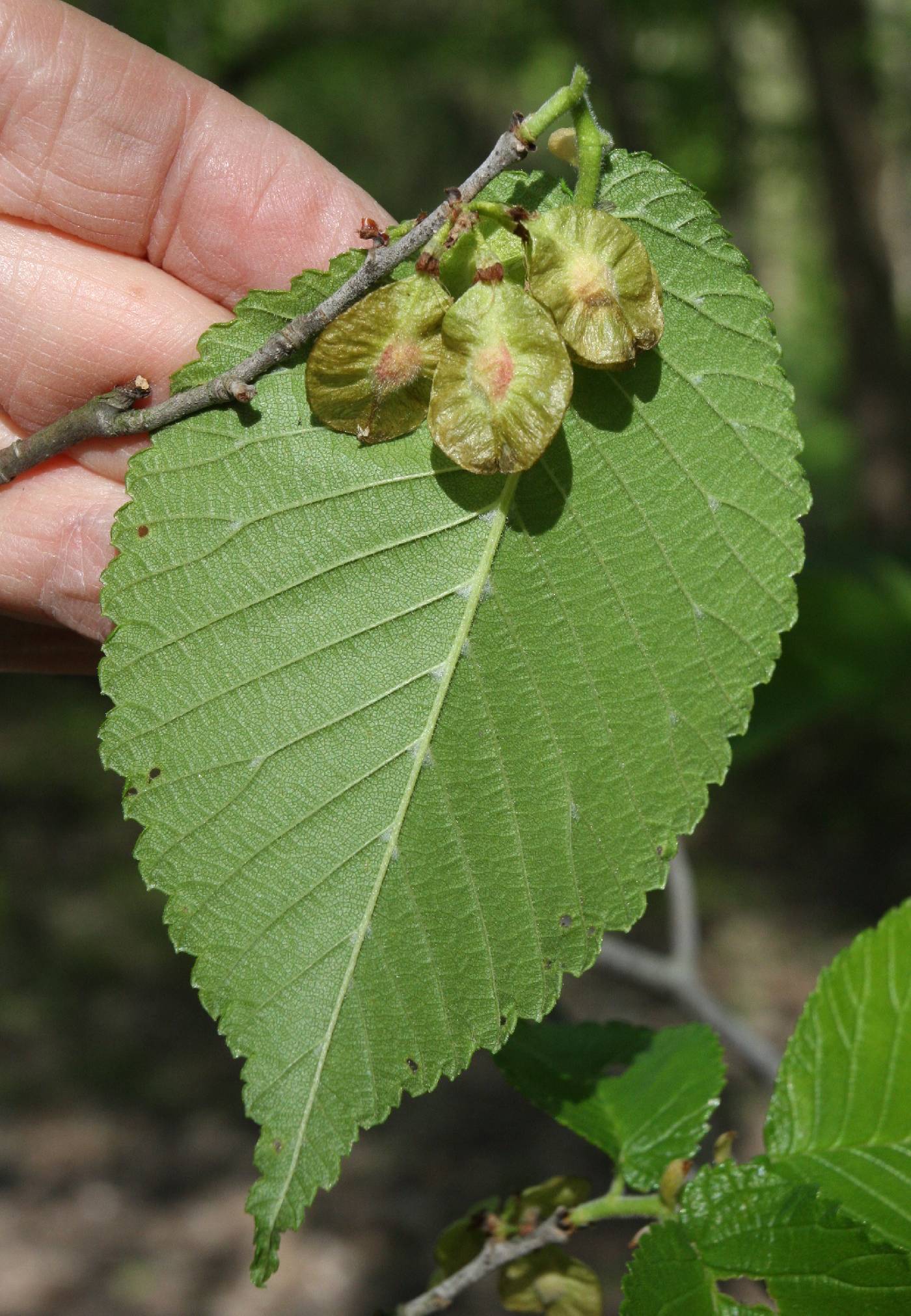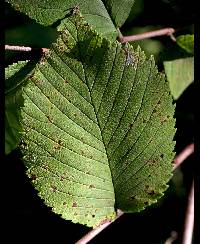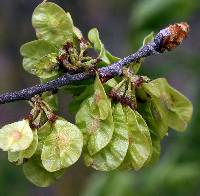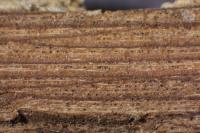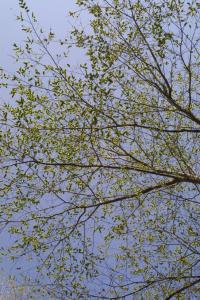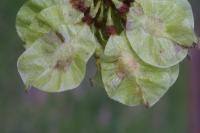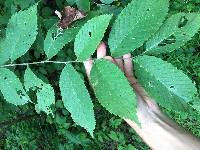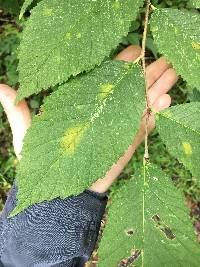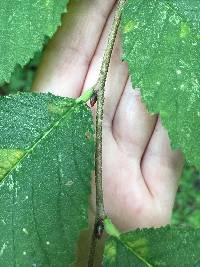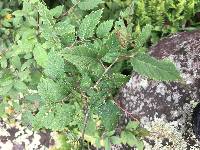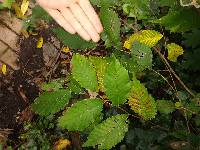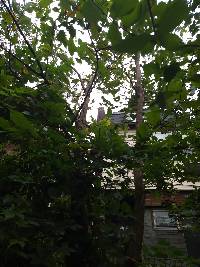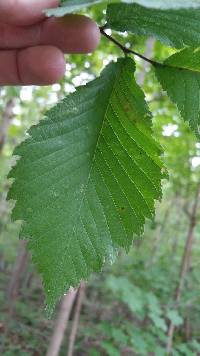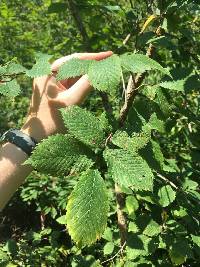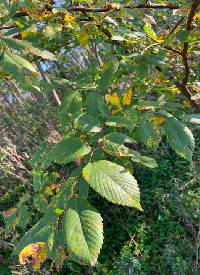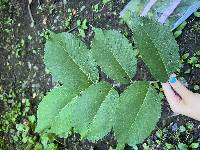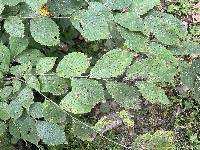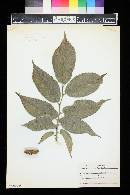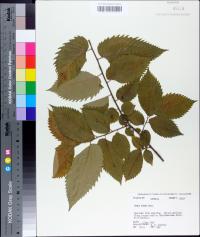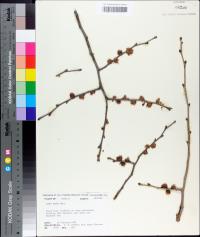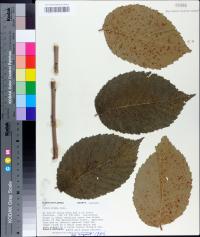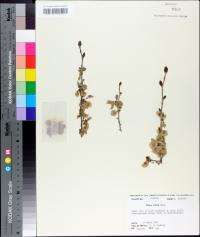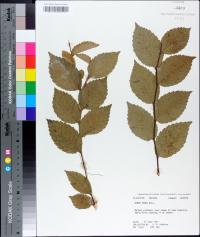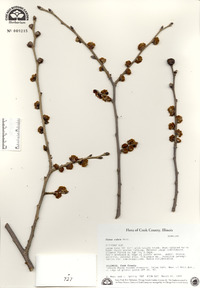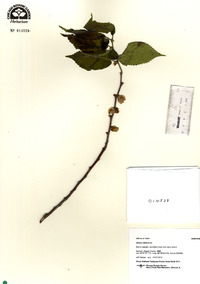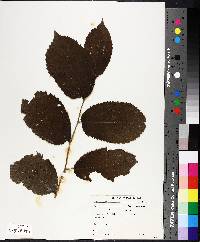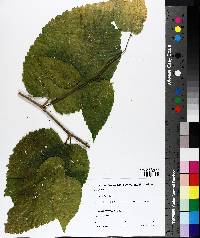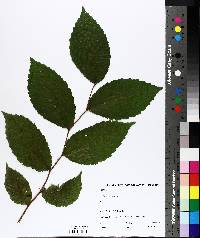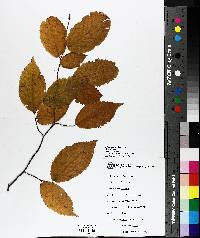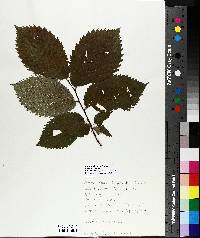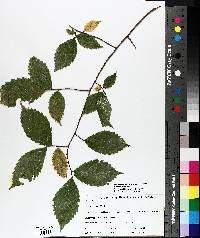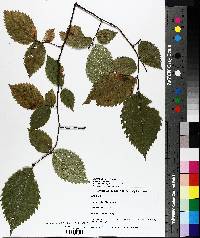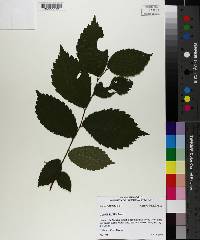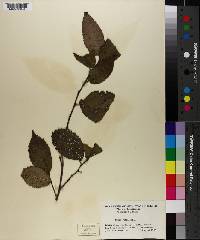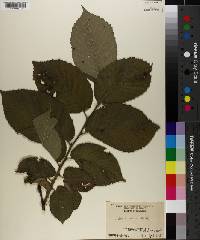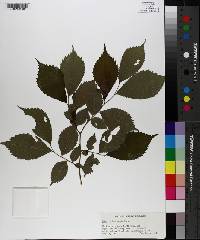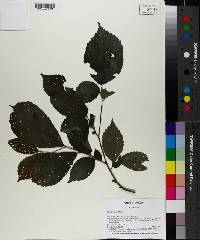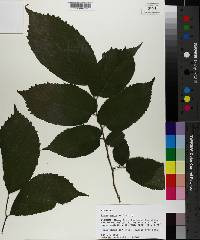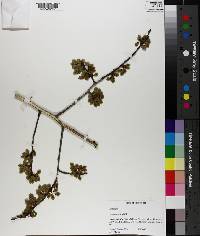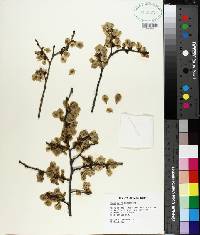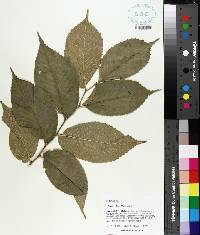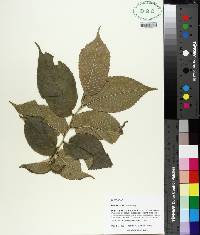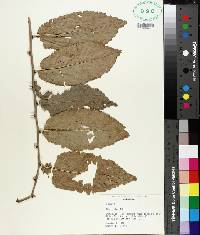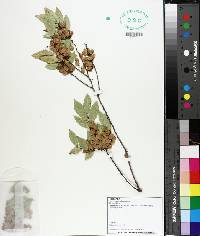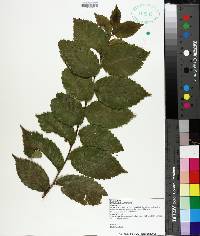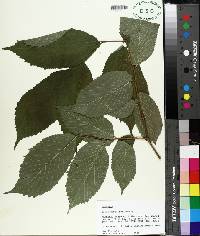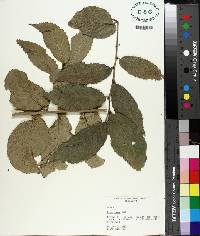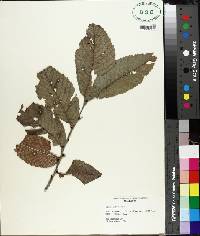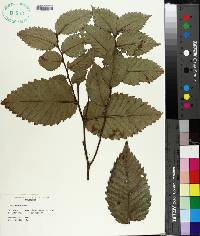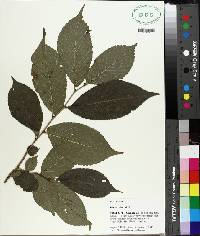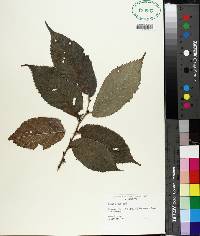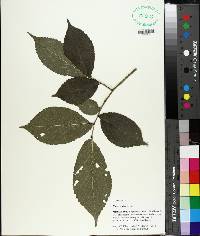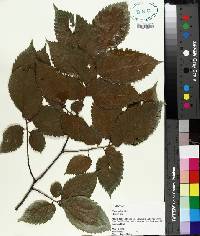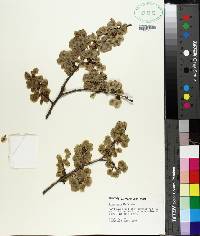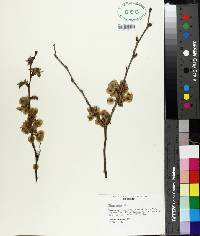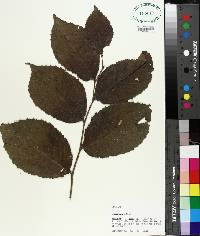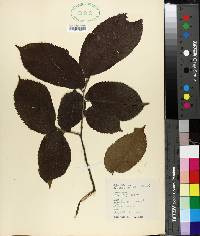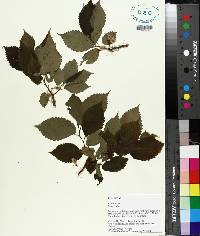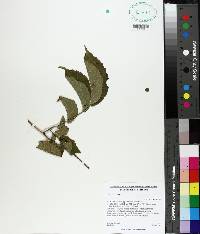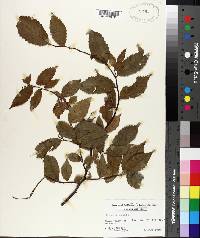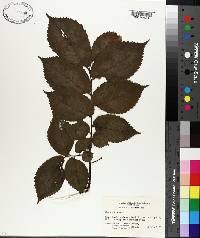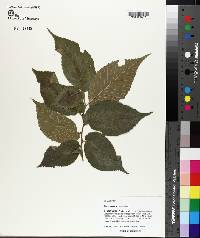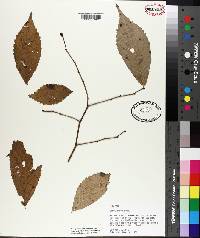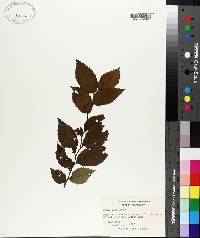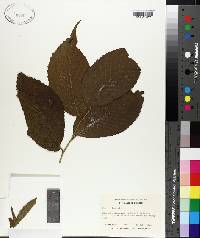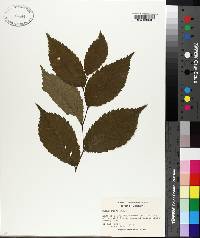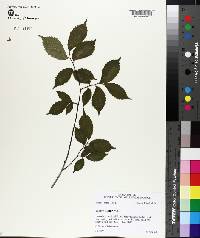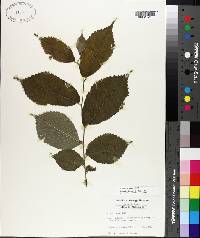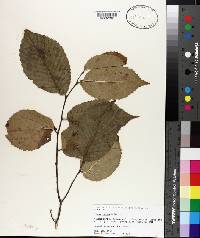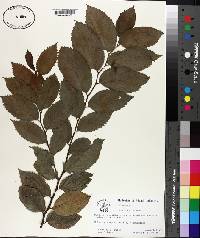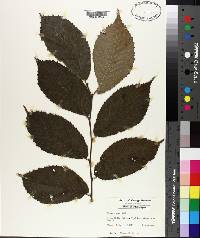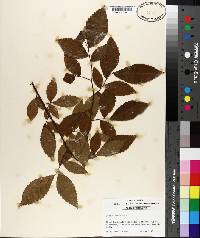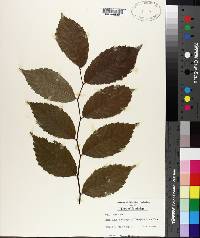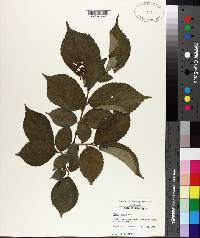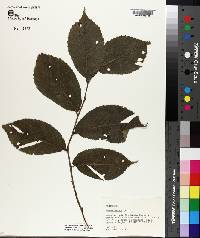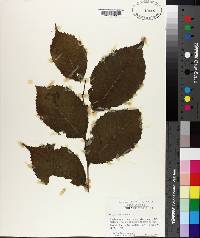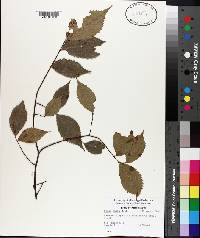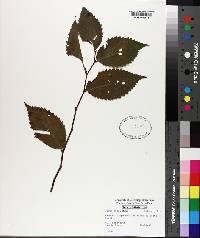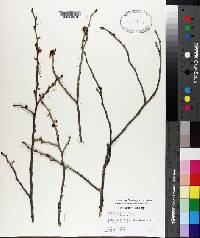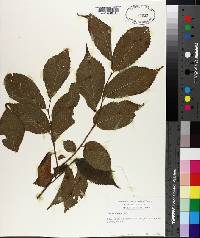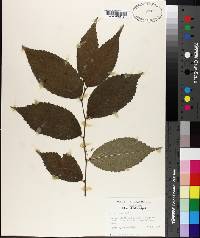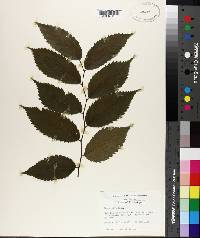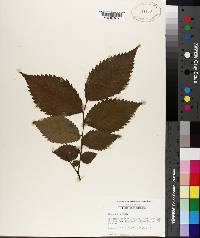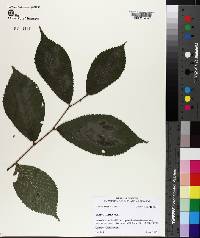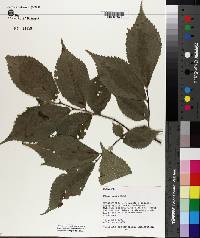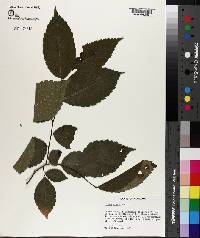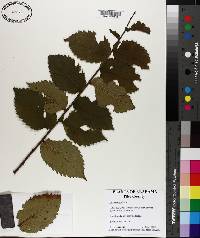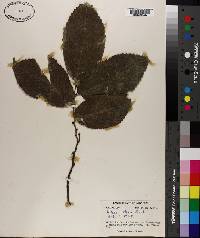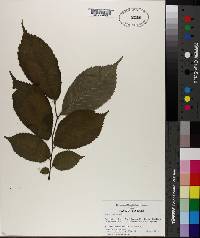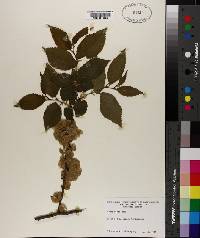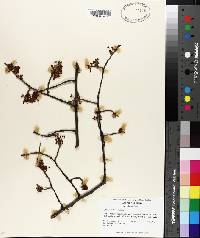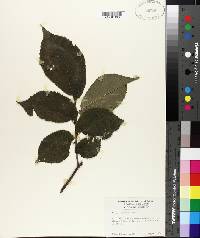Ulmus rubra
|
|
|
|
Family: Ulmaceae
Slippery Elm
[Ulmus fulva Michx., moreUlmus pubescens Walter] |
Trees , 18-35 m; crowns open. Bark brown to red, deeply and irregularly furrowed. Wood soft. Branches spreading; twigs gray, densely pubescent when young, glabrous with age. Buds obtuse; scales red, margins red-tomentose. Leaves: petiole 5-7 mm, pubescent. Leaf blade obovate to ovate, 8-16 × 5-7.5 cm, base oblique, margins doubly serrate in distal 1/2-3/4, singly serrate proximally, basal teeth 6 or fewer, rounded, less distinct, apex acuminate; surfaces abaxially tomentose, dense tufts of white hair in axils of major veins, adaxially harshly scabrous, trichomes pointed toward apex, margins ciliate. Inflorescences dense fascicles less than 2.5 cm, 8-20-flowered, flowers and fruits not pendulous, subsessile; pedicel 1-2 mm. Flowers: calyx green to reddish, shallowly lobed, lobes 5-9, reddish pubescent; stamens 5-9; anthers reddish; stigmas exserted, pink reddish. Samaras yellow to cream, suborbiculate, 12-18 mm diam., broadly winged, samaras pubescent on body only, rusty-tomentose, margins glabrous. Seeds thickened, not inflated. 2 n = 28. Flowering late winter-early spring. Lower slopes, alluvial flood plains, stream banks, riverbanks, and wooded bottom lands; 0-600(-900) m; Ont., Que.; Ala., Ark., Conn., Del., D.C., Fla., Ga., Ill., Ind., Iowa, Kans., Ky., La., Maine, Md., Mass., Mich., Minn., Miss., Mo., Nebr., N.H., N.J., N.Y., N.C., N.Dak., Ohio, Okla., Pa., S.C., S.Dak., Tenn., Tex., Vt., Va., W.Va., Wis. Scabrous-leaved Ulmus rubra is often confused with U . americana . Where ranges coincide, U . rubra may freely intergrade with Ulmus pumila Linnaeus, a widely introduced species. The red-rust, mucilaginous inner bark of Ulmus rubra is distinctive; its sticky slime gives this tree its common name of slippery elm. Native American tribes used Ulmus rubra for a wide variety of medicinal purposes, including inducing labor, soothing stomach and bowels, treating dysentary, coughs, colds, and catarrhs, dressing burns and sores, and as a laxative (D. E. Moerman 1986). Various preparations utilizing it are still marketed.
Medium-sized tree to 15 - 24 m tall, trunk diameter 30 cm - 0.6 m Leaves: alternate, with stout, short, hairy leafstalks. The blade is green and very rough-hairy above, paler and hairy beneath, 10 - 17 cm long, half as wide, and oval to elliptical with an asymmetrical base and pointed tip. It is also coarsely double-toothed, thick, and firm. The veins are forked near the margin. Flowers: in drooping clusters, greenish, small, bell-shaped. Fruit: single-seeded, winged (samara), in dense clusters, short-stalked, 2 cm long, oval. Seed cavity brown and hairy. Wings hairless and shallowly notched at the tip. Bark: dark reddish brown, thick, and shallowly furrowed into large, loose plates. The inner bark is moist and slippery, especially when chewed. Twigs: rather stout, bright green, becoming reddish brown, with short, gray hairs. Leaf scars half-round and covered with a corky layer. Bundle scars three. Buds: dark brown to black, 4 - 6 mm long, nearly round, blunt, with rusty colored hairs (especially at the tip). Flower buds conspicuous and spherical. Form: broadly rounded or occasionally flat-topped, with spreading and ascending branches. Similar species: The rough, sandpaper-like texture and asymmetrical base of its leaves distinguishes Ulmus rubra from all other elms in the Chicago Region. The hybrid U. x notha, of which U. rubra is a parent, differs by having middle bud scales fringed with white hairs and terminal bud scales fringed with reddish brown hairs. Leaves of the genus Celtis, which are similar in appearance, exhibit three main veins arising from the base of each blade. Flowering: late March to late April, before the leaves Habitat and ecology: Frequent in woodlands, often along streams. Second-growth saplings are commonly seen along woodland borders. Has also been found growing in fens and other mesic sites. Occurence in the Chicago region: native Notes: The slippery inner bark of Ulmus rubra forms a moist mass when chewed, and was once used as a thirst quencher. The wood is used for furniture, boxes, crates, barrels, veneer farm implements, fence posts, and shipbuilding. This elm, as well as all native elm species, is susceptible to Dutch elm disease and phloem necrosis. See link to Dutch elm disease below. Etymology: Ulmus is the Latin word for elm. Rubra means red, referring to the rust colored hairs on its buds. Author: The Morton Arboretum Tree to 20 m, with the shape of no. 1 [Ulmus americana L.], the twigs scabrous- pubescent; winter-buds densely covered with red-brown hairs; lvs oblong to obovate, thick and stiff, usually 10-20 cm, very rough above; fls fascicled, subsessile; stamens 5-9; stigmas pink; fr suborbicular, 1.5-2 cm, pubescent over the seed, otherwise glabrous, scarcely reticulate; 2n=28. Moist woods; s. Me. and s. Que. to e. N.D., s. to Fla. and Tex. (U. fulva) Gleason, Henry A. & Cronquist, Arthur J. 1991. Manual of vascular plants of northeastern United States and adjacent Canada. lxxv + 910 pp. ©The New York Botanical Garden. All rights reserved. Used by permission. From Flora of Indiana (1940) by Charles C. Deam This species is found in every county of the state. It is rare to infrequent in a few of our prairie counties but frequent to common in all parts of the state outside of the oak-hickory forests and in wet woodland. Where woodland has been heavily cut over and left for a second crop this species is usually well represented, sometimes forming the major stand. The inner bark was formerly chewed as a remedy for stomach trouble and used in medicine in powdered form for poultices. …… Indiana Coefficient of Conservatism: C = 3 Wetland Indicator Status: FAC Deam (1932): This tree is usually 3-6 dm. iin diameter and tall for its diameter. Larger trees occur. In the Ind. Geol. Rept. (6:70. 1875) mention is made of a tree in Jackson County that was "18 feet in circumference." The uses of the wood are similar to those of white elm. The inner bark collected in spring is much used in medicines underthe name slippery elm. |
|
|
|

